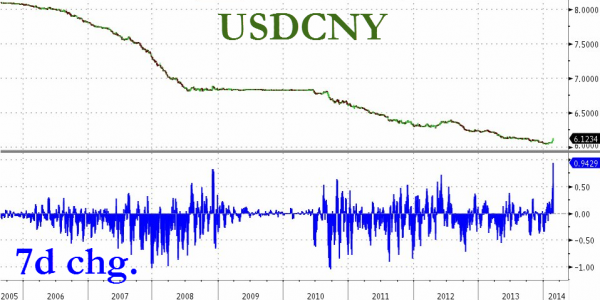The last 7 days have seen the unstoppable ‘sure-thing’ one-way bet of the decade appreciation trend of the Chinese Yuan reverse. In fact, the 0.95% sell-off is the largest since 1994 (bigger than the post-Lehman move) suggesting there is clear evidence that the PBOC is intervening.

Â
The fact that this is occurring with relatively stable liquidity rates (short-term repo remains low) further strengthens the case that China just entered the currency wars per se as SocGen notes,intending to discourage arbitrage inflows. For the Chinese authorities, who do not care about the level of their stock market (since ownership is so low), and specifically want to tame a real-estate bubble, this intentional weakening is clearly aimed at trade – exports (and maintaining growth) as they transition through their reforms. The question is, what happens when the sure-thing carry-trade goes away?
BofA notes the puzzling divergence between Yuan fixings and short-term liquidity,
The turn of the Chinese New Year brought the People’s Bank of China (PBoC) back into action – it not only restarted repo operations to withdraw liquidity, it actually did it at a much higher rate. The 7d reverse repo rate at which the PBoC injects liquidity is 75bp higher than a year ago, a move considered by the market as a 75bp rate hike over the last year. The new 14d repo (liquidity withdrawal) rate is set at 3.8%, 105bp higher than the rate when 28d repo was last conducted on 6 June 2013. Based on a simple framework, this move is equivalent to another 35bp rate hike (Rate corridor, Chinese style, 18 February 2014).
The puzzle is that both money and bond markets nearly totally ignored such an operation. The 7d repo rate is now fixed nearly 200bp lower since 10 February. Such a massive liquidity improvement in the face of the PBoC’s liquidity withdrawal is puzzling, since by 10 February most of the cash used during Chinese New Year should have flowed back into the financial system already.
The FX market move also begs the question as to why liquidity improved over the last couple of weeks. Generally, the onshore repo rate rises as the RMB weakens against fixing; a normal development because FX outflow dries up liquidity. However, the move in February turned things upside down. Look at the sharp divergence between rates and FX


